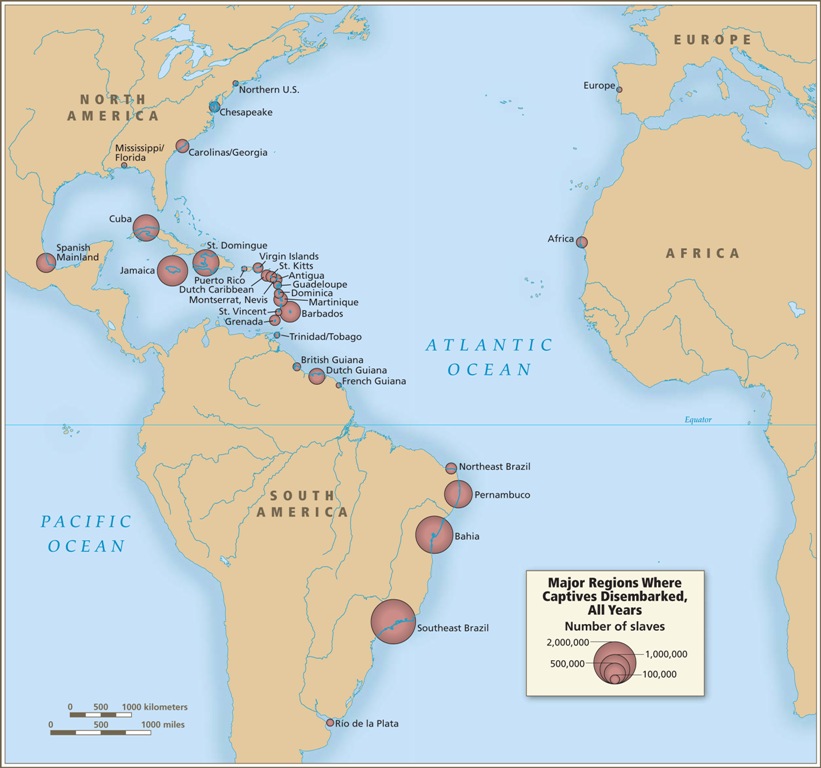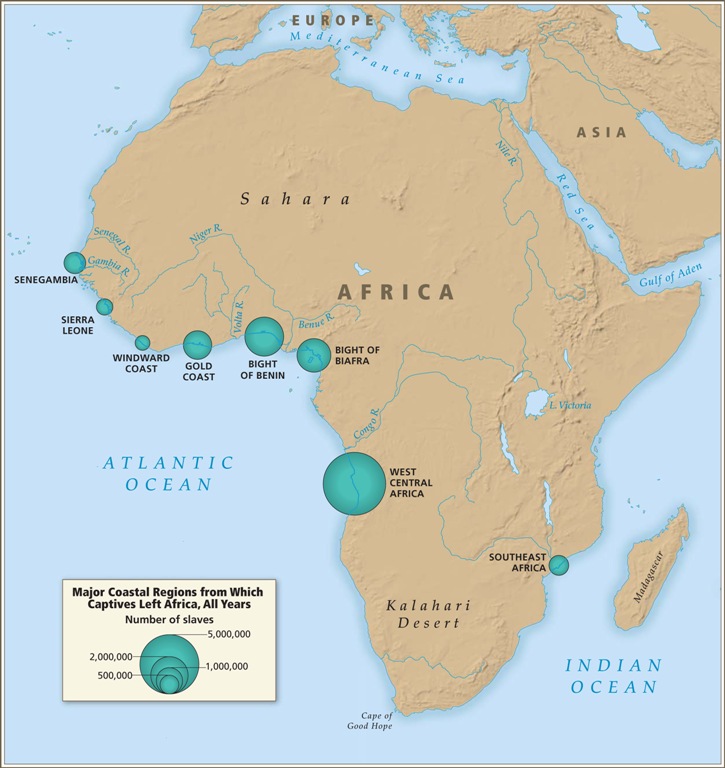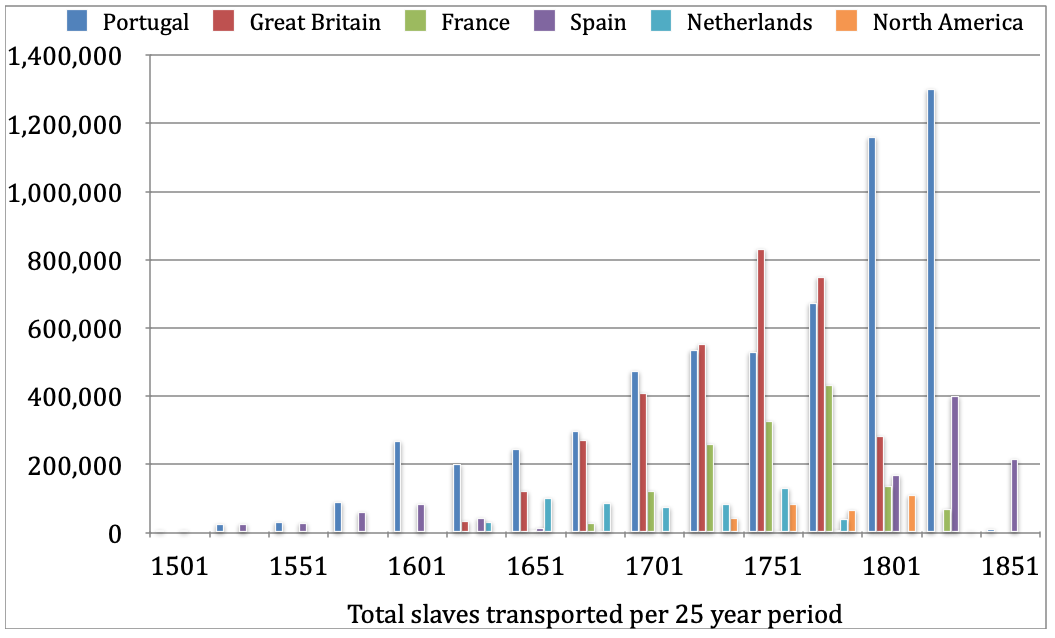

Table of Contents
History is filled with bloody and grim movements, world-changing events and practices as well as long-lasting processes. Yet there aren’t many that combine all of those qualities. Among those usually infamous pieces of our past, the Atlantic slave trade holds a rather notorious place. It influenced the demography, economy, development, and society of at least three continents (four if we count the Americas as separate continents) for roughly 400 years. One of the reasons for such a vast impact is in the sheer volume of the Transatlantic slave trade.
Slavery in the New World
A short introduction
Before we delve into describing the volume of the Transatlantic slave trade, a short historic overview and description are in order. The story of trading in the enslaved on the Atlantic Ocean begins with the Portuguese exploration of the northwestern coast of Africa in the early 15th century. There they found an already existing slave market. They decided to join in, though not for the enslaved but rather seeking gold or spices. However, as they and the Spaniards began exploring further, they found themselves in lack of workforce in new colonies. Thus, instead of reselling the enslaved on the African coast, they decided to send them to numerous Atlantic islands like Sao Tome, the Azores, or the Cape Verde Islands. There they were used for sugar production.
By the early 16th century, as the American continent was discovered and being colonized, the practice expanded across the ocean finalizing the transformation from the Atlantic into triangular Transatlantic slave trade that connected Africa, the Americas, and Europe. Trading with human beings continued over the next three centuries before some began to question the humanity of such actions. Various abolitionist societies emerged, most notably in Great Britain, which became the first nation to abolish the slave trade in the early 19th century. Other nations slowly followed, shutting down the mercantile network by the 1870s.
Arriving to the Americas
In modern media and consciousness, the American side of the Atlantic trade of human beings evokes images of colored people working on a cotton field in the southern US or possibly on sugar plantations in the Caribbean. However, such images could be seen as somewhat of a misconception at least when it comes to the geographical distribution of imported slaves. To mainland North America, as a whole, arrived around 388,000 enslaved people. Though it isn’t a negligible number, it pales to comparison with other locations. For example, Spanish-ruled Cuba received just shy of 800,000 slaves, with entire Spanish colonies going up to 1,3 million people. A similar situation can be seen in the French Saint-Dominique (modern-day Haiti), where some 775,000 slaves were brought. However, the entire French Caribbean dominion accepted roughly 1.1 million Africans.

A maps showing distribution of disembarked African slaves in the Americas. from slavevoyages
Yet the biggest recipient of slaves in the region was British Jamaica, buy over 1 million enslaved people alone. Together with Barbados, which took roughly 500,000 as well, and its other Caribbean colonies, Great Britain arrives at an unbelievable number of 2.3 million slaves. If the mainland numbers are added, Britain and later the independent US, together arrive at 2.7 million slaves. However, undoubtedly the biggest exploiters of the African involuntary workforce is Portuguese Brazil. Its northeastern state of Bahia alone bought over 1.5 million people, while its southeastern region around Rio de Janeiro and Sao Paulo imported 2.2 million enslaved humans. Overall, Brazil as the sole Portuguese colony was a destination to over 4.8 million captured Africans.
When other smaller European colonies in the Americas are added, like the Dutch and the Danish, the grand total of slaves that arrived at the New World comes to about 10.5 million people, at least according to most modern estimates. To put it in perceptive, England in 1700 had just over 5 million people in total.
The old worlds
A deadly voyage across the ocean
The staggering number of over 10 million slaves coming to the Americas is very illustrative of the demographic influence the Transatlantic slave trade had on the New World, changing the population, society as well as the economy of the continent. However, this sum represents only the amount of the enslaved people that actually arrived on the American coast. In reality, many Africans perished as they were transported across the Atlantic Ocean.
The so-called Middle Passage lasted anywhere between 1 up to 6 months, depending on numerous variables. The enslaved people spent most of it cramped up in tight cargo spaces below the decks. They were badly fed, treated inhumanly in various despicable and cruel forms, often succumbing to numerous diseases. The harsh conditions, from being torn away from their societies to being sentenced to a life of misery drove many to suicide as well as rebellion. Unsurprisingly, the mortality rates were high on these journeys, in some rare cases going up to 100%. However, these extremes went both ways, as there were also trips with surprisingly low death counts.
On average, the death toll of the Atlantic voyages was around 18%. This means that the number of Africans were embarked on the slave ships was drastically higher than the number of those who disembarked. With that in mind, the volume of the Transatlantic slave trade goes up to about 12.5 million human beings.
Africa and slavery
Most people today tend to see the entire western coast of Africa as a singular source of the enslaved people used in the Atlantic slave trade. Yet, like with the destinations, the geographical origins of the slaves were diverse. The smallest numbers came from Senegambia, Upper Guinea, and the Windward Coast, the three northernmost regions. Just shy of 1.5 million people were embarked there, with half being from Senegambia. Then came the Gold Coast, further to the south with 1.2 million on its own, followed by the Bight of Biafra with almost 1.6 million enslaved people. On the high end of the scale was Bight of Benin, where roughly 2 million slaves started their Middle Passage, and West Central Africa. The latter was the largest exporter of enslaved humans, with about 5.6 million people or about 40% of all slaves originating from that region. It should be also noted that a small number of slaves originated from southeastern Africa, around Mozambique and Madagascar, some 500,000 of them.

A maps showing regions where the African slaves were embarked on European ships. from slavevoyages
However, this doesn’t mean that the enslaved people necessarily originated from these regions, but that the Europeans merely embarked them on their ships in those locations. They didn’t “hunt” for them, but instead bought them off the local African traders, who acquired from various sources. Some were local criminals or indebted servants. Another smaller percentage were people given as tribute between African states. However, most of the enslaved were captured during wars or slave raids in the interior, places where Europeans rarely ventured, if at all. Thus, in reality, we cannot be sure where those people exactly came from.
These facts also play a role in determining the volume of the Transatlantic slave trade. Historians have little sources on how many people perished on their way to the coast, as those caravans weren’t without their perils. It is also hard to estimate how many died in captivity while on the coast, waiting for months for the ships and merchants to take them away to their horrible fates across the ocean. Some scholars claim that this part of the Atlantic slave trade killed almost 3 times as many people as the voyage across the ocean. If these high estimates are true, it would mean that no less than 17 million enslaved people were part of the Transatlantic slave trade. More conservative approximations would put the total number of slaves to just shy of 14 million people.
European merchants
Another key distinction to be made when talking about the Transatlantic slave trade is concerning European merchants. Like with the regions of embarkation and disembarkation, the role of the various nations in the trade was unequal. For example, the Danish and other Baltic nations played a minor role, with a combined number of embarked slaves barely surpassing 100,000, seemingly satisfying the demands of their colonies. A similar position can be seen with the French whose overall participation ran at about 1.3 million embarked Africans, with about 1.1 surviving the voyage. Thus these were self-sufficient trading nations.
The Spaniards managed to transport just shy of 900,000 enslaved people, meaning they had to trade with other nations to satisfy their demands. In contrast, the Dutch, who are responsible for about 530,000 enslaved sent to the Americas, despite their colonies receiving just about 200,000 Africans. Thus, the Dutch role in the Atlantic slave trade was more in the role of a supplier. Similarly, the British when combined with the US (due to the latter being a part of the British Empire for most of the slave trade) disembarked some 3 million slaves, some 300,000 people more than their colonies imported. Like the Dutch, they traded off their “surplus” to other nations.
Finally, in a category of its own is Portugal, whose numbers are combined with Brazil (for the same reason as for the US and Great Britain). The Portuguese embarked roughly 5.8 million people, with just shy of 5.1 million arriving to the New World. Like the British, the Portuguese also sold some of their slaves to the Spaniards. Yet because of the sheer number of African people they transported they are in a class of their own. With nearly 40% of all imports and 47% of embarked slaves, they could be rightfully deemed as the worst of all slave-trading nations.
Framing the numbers
Historic variation
So far, the numbers that represent the extent of the Atlantic slave trade were presented in a rather crude fashion, in absolutes. Though they are correct, or as close as current scholars can estimate, they may give a false sense that the slave trade never changed through almost 400 years it lasted. Though these changes are worthy of an article on their own, some perspective in this one may be prudent. Firstly, the trade rose in intensity as time passed. A perfect example of this can be the fact that during the entire 15th century, the number of embarked slaves was about 277,000. Yet, at its peak, in the period between 1786 and 1790, no less than 505,000 Africans were boarded on European ships.
Other variations happened through time. An example can be seen in the source of the enslaved Africans. Initially, Senegambia was an almost sole exporting region but was surpassed by West Central Africa in the late decades of the 16th century, remaining the largest exporter of salve until the end. Other regions had their fluctuations according to various local and global circumstances. Similarly, the destinations of the slaves changed through time. The Spanish and the Portuguese were early to start but achieved their peaks in imports only in the first half of the 19th century. In comparison, the French and British Caribbean colonies bought most of their involuntary workforce in the second half of the 18th century.

A graph showing participation of European nations in the slave trade through the years. from wikicommons
Similar fluctuations can be seen in the nation’s share in the overall trade. The Portuguese were the biggest slave traders until around 1720, being surpassed by the British who held their top spot until 1807 and their ban of the slave trade. Then the Portuguese, or rather the Brazilians, retook top position before the final years went to the Spaniards who remained sole traders in human beings. Another important point is that the Middle Passage also changed through time. Better ships led to faster travel times, the conditions for the enslaved improved, as well as did the medicine and other practices. Thus, the voyage mortality dropped from 20-25% in the early years to less than 10% by the late 18th and early 19th centuries.
Tragedy above everything
However, regardless of all these and other changes, representing enslaved people like mere numbers and statistics may lead us away from compassion and a true understanding of what those persons went through. In that perspective of personal tragedy, scholarly arguments if the number was higher or lower from 12. 5 million people if futile. It doesn’t really matter if there were 12 thousand or 12 million when human beings are being traded and treated like cattle. It is a point that all must bear in mind when reading, talking, and thinking about these tough issues from our past.
Nevertheless, no matter how cold and distanced these numbers may seem, the volume of the Transatlantic slave trade is a key component in understanding both the event itself, but also history on a larger scale. It helps with determining the effects and consequences of the slave trade, its historical importance, causes, and impacts. That is why sometimes numbers and statistics mean a lot when painting a picture of our past.
